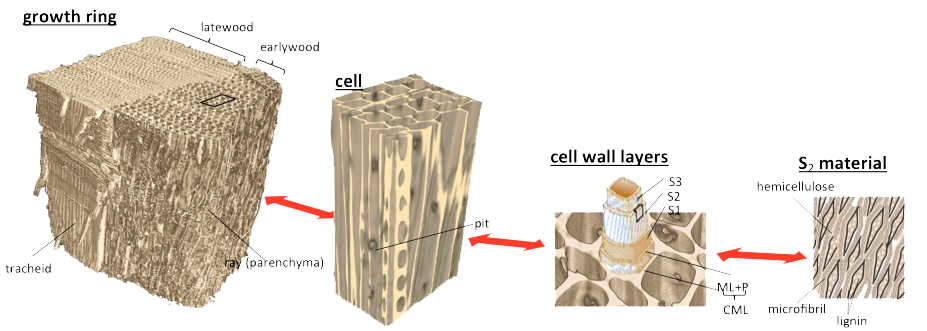Fluids and Porous Materials

Scope of research
We focus on:
- fluid (gas and/or liquid) transport at different pore scales and its coupling to heat transport
- phase change between liquid and gas at molecular, pore and macroscopic scales, including heat of sorption
- coupled mechanical-sorption hysteresis behavior, including swelling–shrinkage, and moisture-induced weakening
- surface phenomena such as droplet impact on porous substrates, film forming and run-off
Multiscale modelling framework
The development of nano-porous materials, with huge specific surface area, tailored pore size and structure, and controlled surface functionality, offers a wide range of potential applications with respect to adsorption, such as gas storage, separation and drug delivery. However, as the pore-size is comparable to the interaction range of molecules, relatively large molecular forces arise between the fluid and solid, leading to a significant deformation of the material. As this phenomenon involves the coupling between sorption and deformation at different scales, we propose a multi-scale modelling method, which starts from the nano-scale and scales up across meso-scale to macro-scale, to describe the coupling between sorption and deformation. Specifically, the molecular simulation methods including Molecular Dynamics and Grand Canonical Monte Carlo simulation are employed at the nanoscale to characterize the origin of sorption induced deformation at the molecular level. At the mesoscale, Finite Element model are constructed to study the effect of the meso-structures with the help of Dependent Domain Theory. In the end, the macroscopic behavior of the material are described by a nonlinear poromechanics model by taking advantage of the information required from simulations conducted at lower level. With the help of the multi-scale modelling method, we can gain better understanding of the interaction between the nano-porous matrix and the nano-confined fluids and then further extend the application of nano-porous materials in various fields.
Multiscale modelling - example with wood
Wood, an orthotropic cellular biomaterial, has the capacity of adsorbing water molecules from the surrounding environment into its hierarchical material structure. As water molecules attach themselves to the hydrophilic matrix in the cell walls, the induced fluid-solid interaction forces result in a swelling of the cell walls. Moisture-induced internal stresses highly influence the hygro-mechanical behavior of wood as observed at the macroscale. Adsorption of moisture in wood, in the hygroscopic range i.e. until around 30% moisture content mass per mass, results in swelling up to 10% volumetrically and reduces the stiffness by orders of magnitude depending of on the grain direction. Wood structural hierarchical levels, from high to low, can be considered as: lumber, growth ring, cell, layered cell wall material. The variation of cellular structure across the growth ring has been found responsible, at least in part, for the anisotropy of swelling and stiffness. From cellular and sub-cellular investigations, it has become clear that the microscopic origin of swelling lies at the scale of the cell wall composite material. This extends our scope down to the nanometer scale, where traditional continuum modeling and experiments fails. In recent years, both atomistic modeling and continuum modelling attempts have been made to understand this hygromechanical behavior. However, in terms of the role of matrix, network of microfibrils and their interfaces, neither approach is sufficient and comprehensive. Thus a multiscale approach, combining molecular dynamics (MD), grand canonical Monte Carlo (GCMC) and finite element method (FEM) with poromechanics, is proposed to capture atomic interactions and upscale them to a much larger domain.
Publications
Rafsanjani, Ahmad, Dominique Derome, and Jan Carmeliet. Poromechanical modeling of moisture induced swelling anisotropy in cellular tissues of softwoods. RSC Advances, 2015, 5(5): 3560-3566.
Rafsanjani, Ahmad, Dominique Derome, Robert Guyer and Jan Carmeliet. Swelling of cellular solids: from conventional to re-entrant honeycombs. Applied Physics Letters 102.21 (2013): 211907.
Rafsanjani, Ahmad, Dominique Derome, and Jan Carmeliet. Micromechanics investigation of hygro-elastic behavior of cellular materials with multi-layered cell walls. Composite Structures 95 (2013): 607-611.
Rafsanjani, Ahmad, Dominique Derome, and Jan Carmeliet. The role of geometrical disorder on swelling anisotropy of cellular solids. Mechanics of Materials 55 (2012): 49-59.
Rafsanjani, Ahmad, Dominique Derome, Falk K. Wittel, and Jan Carmeliet. Computational up-scaling of anisotropic swelling and mechanical behavior of hierarchical cellular materials. Composites Science and Technology 72.6 (2012): 744-751.
Patera A, Jefimovs K, Rafsanjani A, et al. Micro-Scale Restraint Methodology for Humidity Induced Swelling Investigated by Phase Contrast X-Ray Tomography. Experimental Mechanics, 2014, 54(7): 1215-1226.
